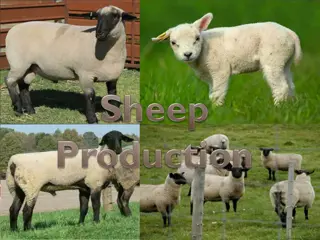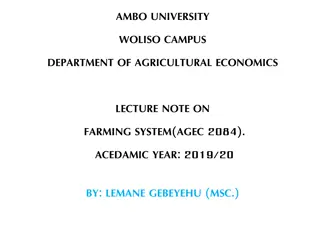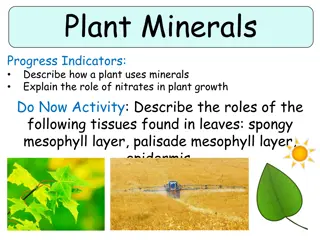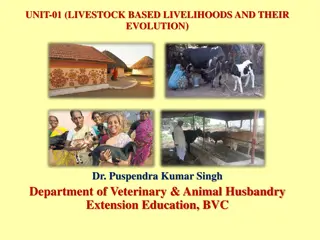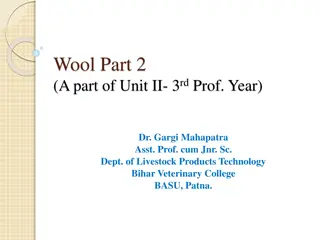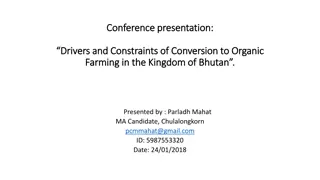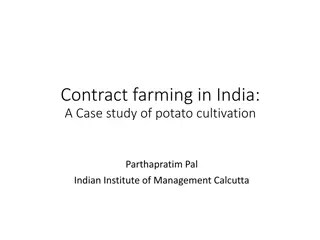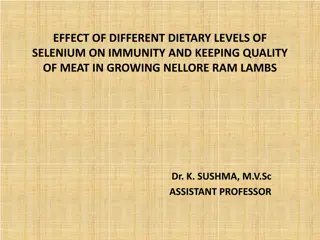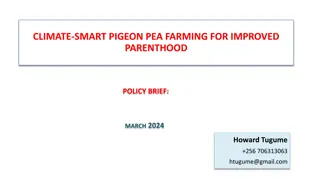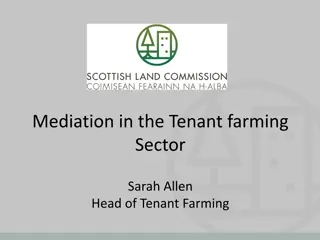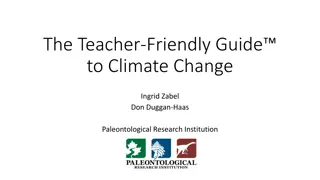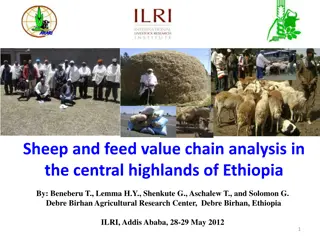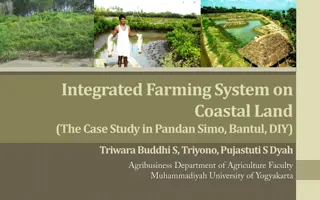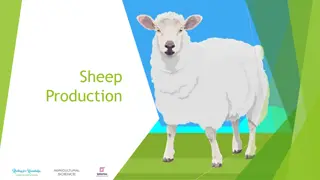Understanding Climate-Friendly Sheep Farming in the UK
UK sheep farming plays a vital role economically, environmentally, and culturally. The industry faces challenges with greenhouse gas emissions, prompting a focus on wool carbon content and mitigation strategies. Sheep contribute to soil health, moorland restoration, insect diversity, and local branding. Various sheep breeds like Primitive Celtic and Viking possess unique traits and benefits. Embracing sustainable practices can enhance the climate-friendliness of sheep farming in the UK.
Download Presentation

Please find below an Image/Link to download the presentation.
The content on the website is provided AS IS for your information and personal use only. It may not be sold, licensed, or shared on other websites without obtaining consent from the author. Download presentation by click this link. If you encounter any issues during the download, it is possible that the publisher has removed the file from their server.
E N D
Presentation Transcript
Introduction UK sheep breeds have a significant economic, environmental and cultural impact Although the data is complicated and incomplete, we recognise that there is a significant issue with GHG emissions from sheep farming Therefore - aimed to help fill knowledge gap by looking at carbon content of wool - Identify steps sheep farmers can take to help mitigate their impact 2 Registered Charity No. 269442
Sheep farming in UK Approx 35 million sheep total sheep meat produced was 288,600 tonnes national income of 2,510million sheep farming supported 34,000 on farm jobs and 111,415 jobs in related sectors (2015 figures) Significant diversity of breeds and attributes 3 Registered Charity No. 269442
Environmental and Cultural impacts Provide environmental benefits in terms of improving soil structure, the removal of plant material through grazing or browsing, nutrient enrichment of the soil through dunging and urination, disturbance of the ground by trampling hooves, physically breaking larger vegetation Significant role in moorland restoration where need control grasses so heather can rejuvenate Strong links to improved insect diversity Highlighting stocking density and having a grazing regime is key. Many breeds have strong local connections, helps in creating locally focussed brands 4 Registered Charity No. 269442
THE BREEDS 5 Registered Charity No. 269442
Primitive Celtic long tailed came from near east through the Mediterranean into southern Britain then spread north Soay , Viking northern short tailed, came to Britain from Asia via Scandinavia and Russia Hebridean, North Ronaldsay horned black faced North Ronaldsay east seaweed feet and legs of dead sea birds Self sufficient little trouble lambing, very hardy, with a natural resistance to parasites and disease, can extract goodness from the coarsest grasses and vegetation Also economic, tastes like game well flavoured low in saturate fats than modern breeds though smaller than other breeds smaller portions satisfy 6 Registered Charity No. 269442
7 Registered Charity No. 269442
8 Registered Charity No. 269442
Longwools Romans brought longwools to England, having selectively bred them since at least second century BC. Very different to the little Celtic sheep, being twice the size The Roman sheep formed a common ancestor to our modern longwool breeds Descendants from Leicester longwool Border Leicester, Wensleydale, Teeswater, Bluefaced Leicester Moorland longwools Whitefaced Dartmoor and Dartmoor Devon and Cornwall produced huge amounts of wool Cotswold and Lincoln rare ,big 9 Registered Charity No. 269442
10 Registered Charity No. 269442
Modern Breeds Origin of modern breeds Medieval sheep farming was highly developed and focussed on wool, but no selection or breeding. The sheep were made up of types, rather than breeds. Breeding becomes more significant in 18 Century to meet the need provide meat for the emerging industrial towns. 20 Century sees the introduction of imported breeds Modern breeds Hill Breeds - Welsh Mountain (several types), Swaledale, Scottish Blackface, Cheviots, Rough Fell, Dalesbred, Derbyshire Gritstone, Herdwick. Upland Breeds - Female hill breeds mated with breeds such as Bluefaced Leicester, Border Leicester, Teeswater, Wensleydale, Devon & Cornwall Longwool. Lowland Breeds - Texel, Suffolk. Charollais, Clun Forest, Romney, Oxford/Hampshire/Dorset Down. 11 Registered Charity No. 269442
Sheep Breeds takeaways We have a very diverse variety of sheep, with different origins and histories The original groups have been improved to create different breeds to meet different needs. These breeds are adapted to different locations and altitudes and so have very different traits This diversity needs to be acknowledged in any study of their impacts and how to address them. 12 Registered Charity No. 269442
SHEEP AND GHGS 13 Registered Charity No. 269442
14 Registered Charity No. 269442
GHG emissions from sheep farming Lamb production systems are associated with three main greenhouse gases (GHGs): Methane - produced as a by-product of digestion via enteric fermentation and manure management practices. Nitrous oxide - emitted from soil following nitrogen fertiliser and manure applications - deposition of urine and dung onto grasslands Carbon dioxide - energy use on farm (e.g. fuel) and during production of animal feeds. 15 Registered Charity No. 269442
The information challenge Likely that variation will be present between lowland, upland and hill sheep systems as available forage, forage quality and animal size, breed and behaviour will all be changeable, but the are significant areas of uncertainty: Variability - environmental factors vary across different altitudes and areas of the country Life Cycle Assessment (LCA) methodology used to measure the environmental impacts over full life cycle, including production, transportation, use and disposal, have to cater for all these variables. Carbon storage in grasslands is also an important function supported by grazing systems but varying methodologies GWP* vs GWP100 accounting methods 16 Registered Charity No. 269442
GHG content of wool RBST commissioned research from NTU Longwood breeds, with other breeds used as a control Provisional findings show the levels of Carbon, Nitrogen, and Hydrogen found in the fleece of various sheep breeds Levels of carbon across current samples 44.3% - 48.5% carbon, nitrogen 11.6%- 15.1% and hydrogen 6.1%-7.3%. Results show the level of carbon stored within the fleece can vary between individuals in a flock. A selection of animals taken who share the same grazing throughout the year on the same paddock system exhibit a variance between 45.5% - 47.7% From samples tested the majority of fleeces composed of 47% carbon were female animals A 3-3.9 carbon to nitrogen ratio has so far been exhibited within samples. 17 Registered Charity No. 269442
GHG sequestration by sheep farming Sequestration implies a long term process In agricultural systems this will primarily be through soil carbon stocks and long terms woodlands 18 Registered Charity No. 269442
Wool processing and emissions 1 19 Registered Charity No. 269442
Wool processing and emissions - 2 20 Registered Charity No. 269442
Sheep and GHGs 21 Registered Charity No. 269442
WHAT SHEEP FARMERS CAN DO 22 Registered Charity No. 269442
What can sheep farmers do? What can sheep farmers do: Diet Health Management Breeding Thanks to Innovation for Agriculture, who have led the way on much of this work 23 Registered Charity No. 269442
Diet Feed Additives 4 Altering the fermentation process in the animal s rumen can reduce the amount of methane being produced. This can be done using different additives, including seaweed. Some foods such as fats and oils do the same Low cellulose diets - 1 If animals are fed a lower amount of cellulose, they will produce a lower amount of methane Low cellulose grasses exist but there is a risk metabolic acidiosis Replacing imported soya as an animal feed 4 Land used to grow animal feed, such as soya, creates significant GHGs. Replacing soya with local alternatives- rapeseed, peas and beans seaweed etc - using less land would reduce this. 24 Registered Charity No. 269442
Health Improving Health 3 Improved health results in animals using feed more efficiently. Sick animals tend to have poorer FCRs particularly Neospora, Infectious Bovine Rhinotracheitis (IBR) and Parasitic Gastroenterits (PGE) 25 Registered Charity No. 269442
Management Grass-legume mixes in pasture 2 Nitrogen fixing legumes help reduce emissions by reducing the need for artificial fertiliser. They also increase the level of protein being fed to the livestock. 26 Registered Charity No. 269442
Breeding Genetic improvement 3 Genetic selection can reduce emissions. Reducing the amount of feed reduces the number of overall emissions. Selecting animals for higher growth rates reduces the number of animals needed to produce a particular quantity of product. Ruminants will reach slaughter weight more quickly, and so in their lifetime will emit less methane and consume fewer outputs. This requires experimenting with breeding strategies and investment in data recording technology. 27 Registered Charity No. 269442
THANK YOU! 28 Registered Charity No. 269442


